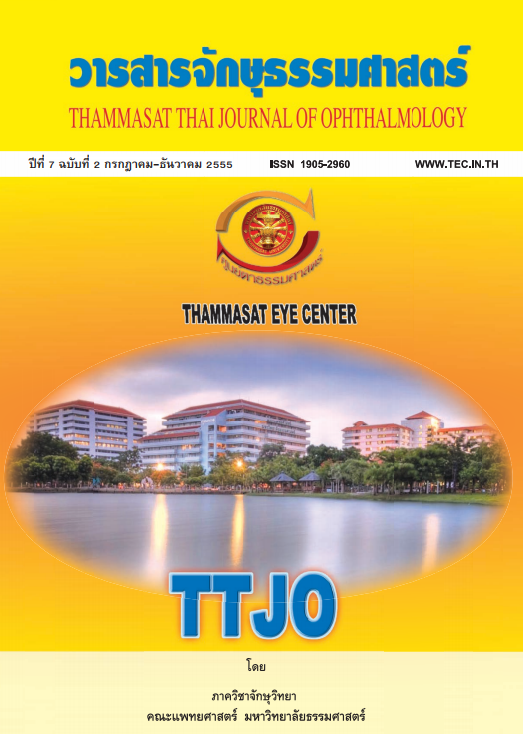การประเมินการพยากรณ์การสูญเสียการมองเห็นโดยใช้ Ocular Trauma Score เปรียบเทียบกับ Classifi cation and Regression Tree ในผู้ป่วยอุบัติเหตุทางตาที่โรงพยาบาลธรรมศาสตร์
Main Article Content
Abstract
วัตถุประสงค์การวิจัย: เพื่อเปรียบเทียบความแม่นยำในการพยากรณ์การสูญเสียการมองเห็นในผู้ป่วยอุบัติเหตุทางตาโดยใช้ the ocular trauma score (OTS)และ the classifi cation and regression tree (CART)
รูปแบบงานวิจัย: Retrospective study
ผู้เข้าร่วมการวิจัย: ผู้ป่วย open globe injuries จำนวน 110 ราย (110 ตา)
วิธีการ: ศึกษาเวชระเบียนผู้ป่วยอุบัติเหตุ openglobe injuries จำนวน 110 ราย ที่ได้รับการรักษาใน รพ.ธรรมศาสตร์ ระหว่างเดือน มกราคม 2550ถึง ธันวาคม 2552 โดยใช้การวิเคราะห์ตามปัจจัย OTSและ CART มาพยากรณ์ระดับสายตาที่ 6 เดือน เทียบกับระดับสายตาจริงของผู้ป่วยที่ระยะเวลา 6 เดือนหลังเกิดอุบัติเหตุ
ผลการศึกษาหลัก: ระดับการมองเห็นที่ 6 เดือน
ผลการศึกษา: เมื่อใช้ปัจจัยพยากรณ์สายตา 6 อย่างของ OTS (ระดับสายตาแรกรับ, globe rupture,การติดเชื้อในลูกตา, perforating injury, ภาวะจอประสาทตาหลุดลอก, afferent pupillary defect)และปัจจัยพยากรณ์สายตา 4 อย่างของ CART (afferent pupillary defect, ระดับสายตาแรกรับ, บาดแผลฉีกขาดเปลือกตา, ตำแหน่งบาดแผล) มาประเมินในผู้ป่วย 110 ราย, ที่ระยะเวลา 6 เดือนพบผู้ป่วยมีการสูญเสียการมองเห็นจริง จำนวน 18 ราย ซึ่งใกล้เคียงกับ การพยากรณ์การสูญเสียการมองเห็นในทุก categoryของ OTS และในทุกกลุ่มของ CART
สรุป: ทั้ง OTS และ CART สามารถใช้ในการพยากรณ์ การสูญเสียระดับการมองเห็นในผู้ป่วยอุบัติเหตุทางตา ชนิด open globe ได้อย่างรวดเร็ว สามารถนำมาประยุกต์ใช้ทางคลินิกได้
A Retrospective Comparative Study of the Ocular Trauma Score and
the Classifi cation and Regression Tree for Prediction in Visual loss in
Thammasat Hospital
Abstract
Objective: To compare the accuracy of predictive value between The Ocular Trauma Score (OTS) and the Classifi cation and Regression Tree (CART) asthe prognostic value of visual loss.
Methods: We evaluated 110 eyes from 110 patients with open globe injuries in Thammasat Hospital from January 2007 to December 2009. All 110 eyes were evaluated by the OTS and the CART. The visual prognostic factors were used to identify the specifi city of patients with fi nally no vision at 6 months visit and compared between OTS and CART.
Results: Of 6 factors (initial vision, rupture globe, endophthalmitis, perforating injury, retinal detachment and afferent pupillary defect) in the OTS and 4 factors (initial vision, afferent pupillary defect, lid laceration and wound location) in the CART are evaluated in 110 patients. At 6 months follow-up time, 18 patients reported no light perception vision. The visual loss in all category groups could be predicted by the OTS and the CART. The result of this study determined that all OTS and the CART had a greater predictive accuracy.
Conclusions: Both the OTS and the CART can be useful methods in predicting the visual loss in open globe injuries and can be useful in clinical practice.


